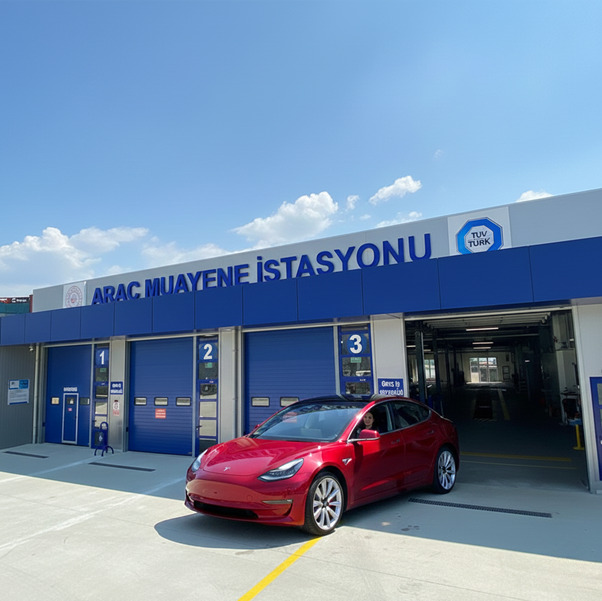Vehicle inspection in Turkey, conducted by TÜVTÜRK, is mandatory for electric vehicles as well to ensure road safety. Since electric vehicles do not undergo engine or exhaust emission tests, the inspection focuses on critical components like battery safety, high-voltage cables, and brake systems.

What is Vehicle Inspection and Why is it Necessary?
Vehicle inspection is the process of officially auditing the technical safety and roadworthiness of all vehicles entering traffic. In Turkey, this process is carried out by TÜVTÜRK, and electric vehicles have the same inspection obligation as internal combustion vehicles. The main purpose of the inspection is to protect both the driver and road safety. Since there are no engine and exhaust checks in electric vehicles, the process moves faster in some aspects; however, battery safety, high-voltage cables, braking systems, and lighting equipment constitute the critical points in the inspection of electric vehicles.
How Often is Vehicle Inspection Performed?
The inspection period for electric vehicles is the same as for internal combustion passenger cars: The first inspection is performed at the end of the 3rd year, and subsequent inspections are performed every 2 years. For electric vehicles used for commercial purposes, this period is determined as every year. In other words, whether electric or gasoline, the vehicle's purpose of use directly affects the inspection period.
What Are the Required Documents for Vehicle Inspection?
The documents required when going to an electric vehicle inspection are not unique; as with all motor vehicles, the license (vehicle registration document) and valid traffic insurance must be presented. Since electric vehicles do not have an exhaust, exhaust emission measurement is not mandatory, which makes the inspection process one step easier. If there is no additional system such as LPG/CNG in the vehicle, the document requirement is completed quite simply.
How Does the Electric Vehicle Inspection Process Proceed?
Since electric vehicles have a different architecture than classic motor vehicles, certain checks stand out during the inspection process. Inspection of the braking system covers both regenerative braking and classic brake discs and pads. Additionally, the vehicle's battery compartment, high-voltage lines, insulation status, chassis and body structure, lighting equipment, and suspension system are evaluated in detail. As electric vehicles do not have oil, exhaust, or internal engine components, checks are not performed in these areas, which makes the process simpler.

How Often is Electric Vehicle Inspection Performed?
The inspection interval for electric vehicles is every 2 years for passenger use, with a 3-year period allowed for the first inspection. Commercial electric vehicles are subject to the annual inspection obligation in the same way as other vehicles in the commercial class.
How is Electric Vehicle Inspection Conducted?
During inspection, the basic control areas for electric vehicles are battery safety and high-voltage systems. The underbody battery case, cable lines, and electrical insulation are examined visually and with equipment; the regenerative braking system is tested together with classic brakes; and due to the high weight of the vehicle, the durability of the suspension and running gear is meticulously measured. After all these checks are made, if the vehicle meets technical sufficiency, it passes the inspection.
Points to Consider During the Inspection Process
For the electric vehicle inspection to pass smoothly, primarily, warning lights should not be on, brake and tire conditions must be good, lighting systems must be fully functional, the battery undercarriage must be undamaged, and external equipment such as the charging socket cover must be intact. Although brake pads wear out later in electric vehicles thanks to the regenerative system, brake performance is still one of the most frequently encountered problems in inspections. Regular checks are the most important key to passing this process smoothly.
In addition to this topic, you can find explanations regarding ChargeIQ's usage processes and frequently asked questions about electric vehicle charging technologies in the FAQ section, and access the information you need quickly.
Sources
- TÜVTÜRK, Sıkça Sorulan Sorular sayfası (TÜVTÜRK, Frequently Asked Questions page) - https://www.tuvturk.com.tr/muayene-rehberi/sss
- TÜVTÜRK, Zorunlu Muayene Bilgisi (Mandatory Inspection Information) - https://www.tuvturk.com.tr/hizmetlerimiz/muayene-hizmetleri/zorunlu-muayene
- TÜVTÜRK, Periyodik Araç Muayenesi Bilgisi (Periodic Vehicle Inspection Information) - https://www.tuvturk.com.tr/hizmetlerimiz/muayene-hizmetleri/periyodik-arac-muayenesi
- Google Gemini AI was utilized for visuals.








